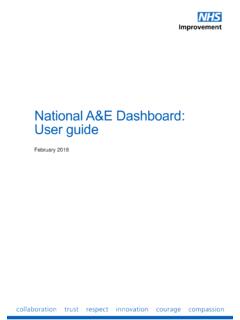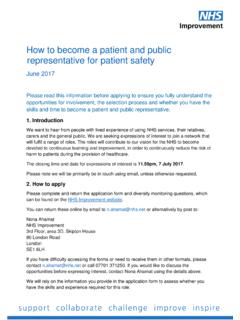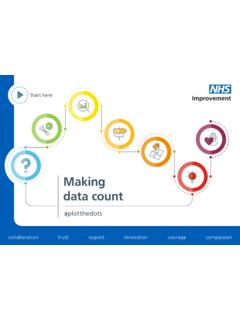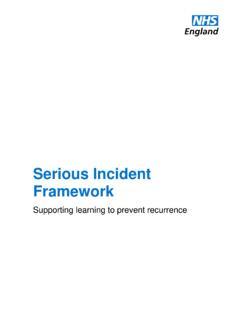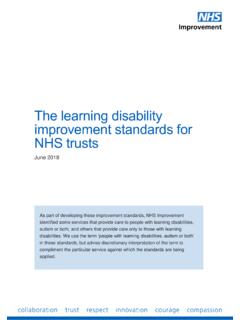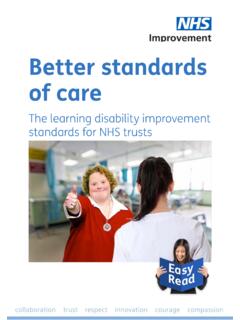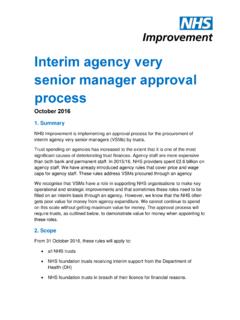Transcription of Patient Reducing the risk of oxygen tubing Safety Alert
1 Classification: Official Patient Reducing the risk of oxygen tubing being connected to air flowmeters Safety Alert 4 October 2016. Alert reference number: NHS/PSA/D/2016/009 Actions Alert stage: Three - Directive Severe harm or death can occur if medical air is accidentally administered Who: All hospitals (or any to patients instead of oxygen . A Rapid Response Report (RRR) issued by other sites) providing NHS. the National Patient Safety Agency (NPSA) in 20091 highlighted the risk and requested that trusts develop action plans to prevent these incidents. funded care that supply However, events continue to occur. Since January 2013 the National medical air using medical gas Reporting and Learning System (NRLS) has received two reports of fatalities, two of severe harm, and over 200 of incidents resulting in moderate, low or pipeline systems (MGPSs)*. no harm. A recent report reads: Patient arrested a further time secondary to hypoxia. It was then When: To begin as soon as discovered that Patient was inadvertently being ventilated with medical air possible and to be completed from piped supply for up to ten minutes.
2 The medical air and the oxygen outlets were side by side, both with flowmeters attached. It was very difficult by 4 July 2017. to tell which flowmeter was which, particularly in an emergency situation.. Air and oxygen flowmeters can be difficult to tell apart and as they both have universal outlets, oxygen tubing can be attached to both. International 1 Identify a named individual who will connector standards are being developed for breathing systems and driving take responsibility for co-ordinating gases However, it is unclear at present whether these new the delivery of the actions required by connectors will differentiate oxygen and medical air. Even if they do, it can this Alert . take industry many years to adopt a new design. Other solutions are required in the meantime. 2 Implement systems to ensure that the three barriers to human error Three barriers to human error have already been recommended by the NPSA1 described in this Alert are all in place and British Thoracic Society (BTS)3 but continuing incidents suggest they have in all relevant clinical areas.
3 Not been universally implemented: 3 Establish ongoing systems of audit Medical air terminal units (wall outlets) are covered with or equipment checks to ensure the designated caps in areas where there is no need for medical air. barriers are maintained. Medical air outlets were traditionally built into most clinical areas for the delivery of nebulised treatment but not all areas need them (eg 4 Share what you learn from they never have patients who need nebulisers, or they have access to implementing this Alert or locally electrically driven compressors or ultrasonic nebulisers). developed good practice resources Medical air flowmeters are removed from terminal units (wall by emailing outlets) and stored in an allocated place when not in active use Removing unnecessary equipment is a more effective method of Reducing human error than adding labels or warnings alone. Air flowmeters are fitted with a labelled, movable flap See page 2 for technical notes, The lettering on the flap is larger and more visible than on the flowmeter supporting information and itself and this flap has to be lifted to attach a tube.
4 This acts as a further references barrier to unintended connection if staff occasionally forget to remove medical air flowmeters after a period of active use. *Although this Alert is directed at sites that use piped medical air, Air flowmeters are never required in an emergency situation (eg a cardiac there is still useful learning in the arrest) and the lack of immediate access to medical air does not introduce supporting information for those risks to patients. See supporting information that use cylinders to provide air and alerts/ Reducing -risk- oxygen - tubing -being -connected-air-flowmeters for further details, other potential barriers and local implementation examples. oxygen . Patient Safety Contact us: NHS Improvement (October 2016) Publication code: IT 08/16. Classification: Official Alert reference number: NHS/PSA/D/2016/009. Alert stage: Three - Directive Technical notes Patient Safety incident reporting The NRLS was searched on 15 June 2016 for incidents reported between 1 January 2013 and 15 June 2016 that contained the keywords air' and oxygen ' in the free text descriptions: 5,943 reports were identified.
5 A sample of 593 incidents were reviewed. All remaining incidents were searched for the keywords instead' or flowmeter'. (using the Excel find function'). In total 208 incidents were identified where oxygen tubing had been connected inadvertently to a medical air flowmeter. For further details please see supporting information via the link below. Supporting information Reducing the risk of oxygen tubing being connected to air flowmeters - supporting information uk/news-alerts/ Reducing -risk- oxygen -tubi ng-being-connected-air-flowmeters References 1. NPSA (2009) oxygen Safety in hospitals | Rapid Response Report 2. ISO 80369 Small-bore connectors for liquids and gases in healthcare applications: Part 1: General requirements Part 2: Connectors for breathing systems and driving gases applications htm?csnumber=50730. 3. BTS (2008) Guideline for emergency oxygen use in adult patients quality-standards/emergency- oxygen -use-i n-adult-patients-guideline/. Stakeholder engagement British Thoracic Society DH/NHS Estates and Facilities UK National Medical Gas Sub Group MHRA.
6 Medical Device Safety Officers (MDSO) network Medical Specialities Patient Safety Expert Group National Patient Safety Response Advisory Panel Patient Safety Contact us.

